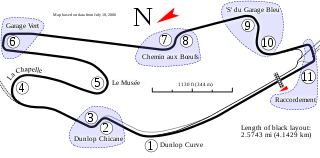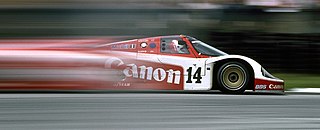
Sports car racing is a form of motorsport road racing which utilises sports cars that have two seats and enclosed wheels. They may be purpose-built (Prototype) or related to road-going models. Broadly speaking, sports car racing is one of the main types of circuit auto racing, alongside open-wheel single-seater racing, touring car racing and stock car racing. Sports car races are often endurance races that are run over relatively large distances, and there is usually a larger emphasis placed on the reliability and efficiency of the car than in some of the other types of auto racing. The FIA World Endurance Championship is an example of a sports car racing series.

Endurance racing is a form of motorsport racing which is meant to test the durability of equipment and endurance of participants. Teams of multiple drivers attempt to cover a large distance in a single event, with participants given a break with the ability to change during the race. Endurance races can be run either to cover a set distance in laps as quickly as possible, or to cover as much distance as possible over a preset amount of time.

Group C was a category of motorsport, introduced by the FIA in 1982 and continuing until 1993. Group C applied to sports car racing, with Group A for touring cars and Group B for GTs.

The World Sportscar Championship was the world series run for sports car racing by the FIA from 1953 to 1992.

The 2003 1000 km of Le Mans was a one-off sports car event run under the organization of the Automobile Club de l'Ouest (ACO) in preparation for the Le Mans Endurance Series that began in 2004. It was run on 9 November 2003 at the Bugatti Circuit near Le Mans, France.

The 1985 World Sportscar Championship season was the 33rd season of FIA World Sportscar Championship motor racing. It featured the 1985 World Endurance Championship which was contested over a series of races for Group C1 and Group C2 Prototypes, Group B GT Cars and IMSA GTP cars. The series ran from 14 April 1985 to 1 December 1985 and was composed of 10 races.
The 1984 World Sportscar Championship season was the 32nd season of FIA "World Sportscar Championship" motor racing. It featured the 1984 FIA World Endurance Championship, which was open to FIA Group C1, Group C2 and Group B cars and to IMSA GTP, GTX, GTO and GTU cars. The championship was contested over an eleven race series which ran from 23 April to 2 December 1984.

The 2001 European Le Mans Series season was the only season for the IMSA European Le Mans Series. It is a series for Le Mans Prototypes (LMP) and Grand Touring (GT) race cars divided into 4 classes: LMP900, LMP675, GTS, and GT. It began 17 March 2001 and ended 6 October 2001 after 7 races.

The Japan Le Mans Challenge was an endurance sportscar series based in Japan built around the 24 Hours of Le Mans that began in 2006. It was run by the Sports Car Endurance Race Operation (SERO) sanctioning body and ran under the rules laid out by the Automobile Club de l'Ouest (ACO). It is the first endurance sportscar series in Japan since the demise of the All Japan Sports Prototype Championship in 1992, although the ACO had run a single endurance race since then, the 1999 Le Mans Fuji 1000 km. The series was cancelled in 2007 following two poor seasons.

The Rolex Sports Car Series was the premier series run by the Grand American Road Racing Association. It was a North American-based sports car series founded in 2000 under the name Grand American Road Racing Championship to replace the failed United States Road Racing Championship. Rolex took over as series sponsor in 2002.
Richard Lloyd Racing (RLR), originally named GTi Engineering, was a British auto racing team created in 1977 by driver Richard Lloyd. Originally named for the Volkswagen Golf GTIs that Lloyd raced in the British Saloon Car Championship (BSCC), they went on to become a successful Porsche privateer in the World Sportscar Championship (WSC). Richard Lloyd Racing eventually folded at the end of the 1990 season due to the increased cost of the World Championship.
Group 6 was the official designation applied by the FIA to two motor racing classifications, the Prototype-Sports Car category from 1966 to 1971 and the Two-Seater Racing Cars class from 1976 to 1982.
The European Sportscar Championship was a name used by several sports car racing championships based in Europe. Initially created in 1970 by the Fédération Internationale du Sport Automobile (FISA) as the European 2-Litre Sports Car Championship for Makes, the series increased in popularity and eventually became part of the World Sports Car Championship in 1976 even after a troubled 1975 season. Only two years later, as interest in sports-prototypes faded, the championship was downgraded from World Championship status and a European championship returned once more, only to be cancelled after its sole 1978 season.

The 2009 American Le Mans Series season was the 39th season for the IMSA GT Championship, with it being the eleventh season with the American Le Mans Series moniker. It began on March 21, 2009, and ended on October 10, 2009 after ten events. The series was composed of Le Mans Prototypes (LMP) and Grand Tourer (GT) race cars divided into four classes: LMP1, LMP2, GT1, and GT2. A fifth category, known as the Challenge class, was also added for select races and featured Porsche 997 GT3 Cup cars from the IMSA GT3 Cup Challenge. 2009 was also the final year for GT1, with Corvette Racing abandoning the class after Long Beach and switching over to much more competitive GT2 class.

The Asian Le Mans Series is an Asian sports car racing endurance series created by the Automobile Club de l'Ouest (ACO) and based in Asia. It is the successor to the defunct Japan Le Mans Challenge which folded in 2007 after its second season. The ACO aims to attract teams and drivers from Asian countries.

The 6 Hours of Fuji is a sports car race held at Fuji Speedway in Oyama, Shizuoka, Japan. The race was held for the first time in 1967, and in 1977 became part of the new Fuji Long Distance Series. In 1982 a second 1000 km race known as WEC in Japan was run as a round of the World Sportscar Championship. The All Japan Sports Prototype Championship was formed in 1983, and since then co-sanctioned this event. The World Championship left after 1988, but the JSPC carried on both races until 1992. The race was revived in 1999 as an attempt to gauge interest in an Asian Le Mans Series; the series never materialized. The race was revived again as a part of the short-lived Japan Le Mans Challenge in 2007. The race returned again as part of the 2012 FIA World Endurance Championship season, but changed to a 6-hour race, with no distance limit.
The 1992 All Japan Sports Prototype Car Endurance Championship was the tenth and final season of the All Japan Sports Prototype Championship, which would be replaced by the All Japan Grand Touring Car Championship, as sportscar racing in the early 1990s changed drastically with the decline of prototypes. The C1 class champion was the #1 Nissan Motorsports Nissan R92CP driven by Kazuyoshi Hoshino and the C class champion was the #7 and #36 TOM'S Toyota TS010 driven by Geoff Lees.

The 2014 FIA World Endurance Championship season was the third season of the FIA World Endurance Championship auto racing series, co-organized by the Fédération Internationale de l'Automobile (FIA) and the Automobile Club de l'Ouest (ACO). The series was open to Le Mans Prototypes and grand tourer-style racing cars from four ACO categories. World Championship titles were awarded for Le Mans Prototypes drivers and for LMP1 manufacturers, and several World Endurance Cups and Endurance Trophies were also awarded. The eight race series began in April at the Silverstone Circuit and concluded in November at the Autódromo José Carlos Pace.
The 2018–19 FIA World Endurance Championship was the seventh season of the FIA World Endurance Championship, an auto racing series co-organised by the Fédération Internationale de l'Automobile (FIA) and the Automobile Club de l'Ouest (ACO). The series is open to Le Mans Prototypes and grand tourer-style racing cars divided into four categories. The season marked the first move to a winter schedule for the championship, with the season starting at the Circuit de Spa-Francorchamps in May 2018 and concluding at the 24 Hours of Le Mans in June 2019. World championship titles were awarded for LMP drivers, GTE drivers, LMP1 teams and GTE manufacturers.
The 2019–20 FIA World Endurance Championship was the eighth season of the FIA World Endurance Championship, an auto racing series co-organised by the Fédération Internationale de l'Automobile (FIA) and the Automobile Club de l'Ouest (ACO). The series is open to Le Mans Prototypes and grand tourer-style racing cars divided into four categories. World Championship titles were awarded for LMP drivers, LMP1 teams, GTE drivers and GTE manufacturers. With the new winter scheduling format, the series began at Silverstone Circuit in September 2019 and ended with the 8 Hours of Bahrain in November 2020.












